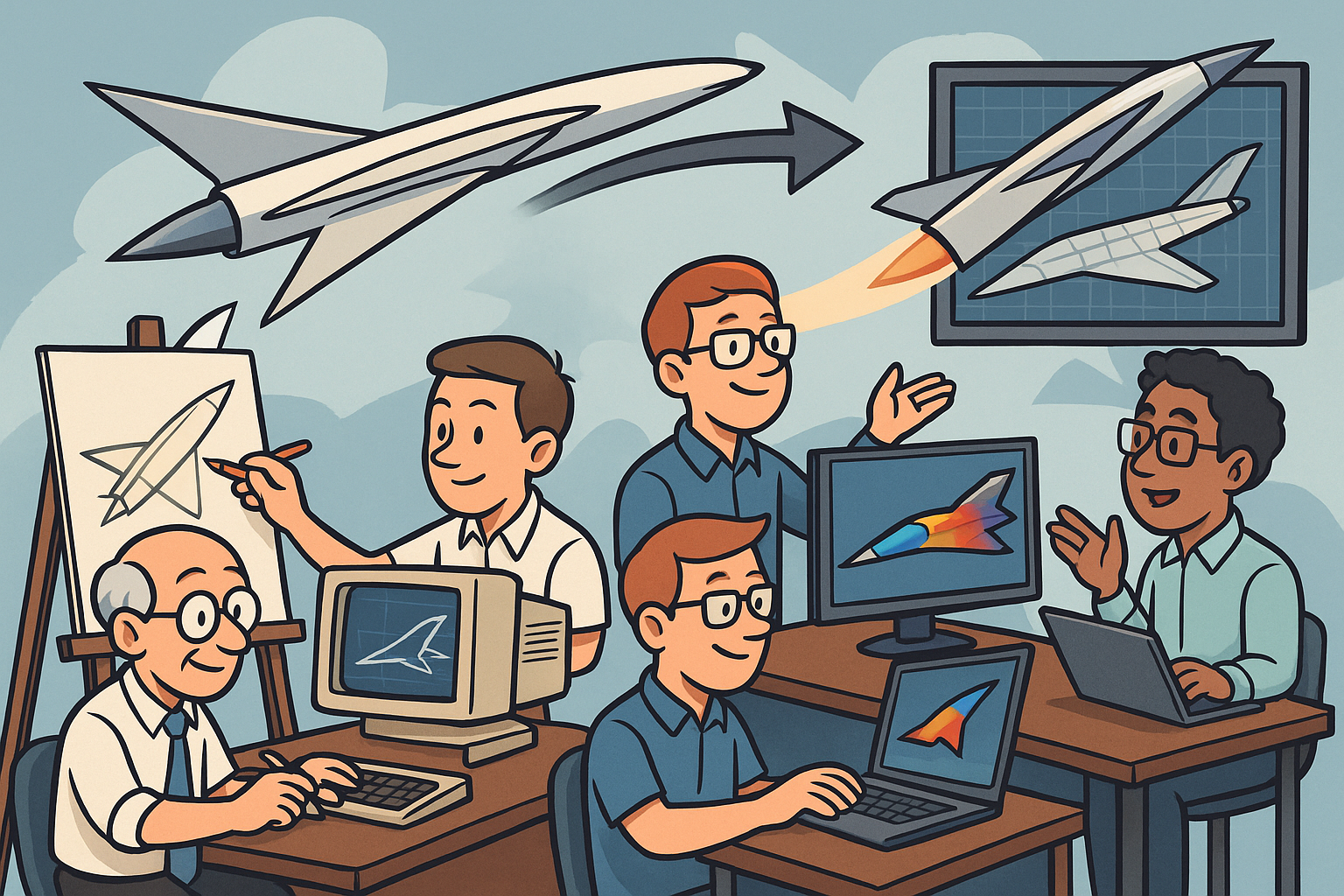Your Cart is Empty
Customer Testimonials
-
"Great customer service. The folks at Novedge were super helpful in navigating a somewhat complicated order including software upgrades and serial numbers in various stages of inactivity. They were friendly and helpful throughout the process.."
Ruben Ruckmark
"Quick & very helpful. We have been using Novedge for years and are very happy with their quick service when we need to make a purchase and excellent support resolving any issues."
Will Woodson
"Scott is the best. He reminds me about subscriptions dates, guides me in the correct direction for updates. He always responds promptly to me. He is literally the reason I continue to work with Novedge and will do so in the future."
Edward Mchugh
"Calvin Lok is “the man”. After my purchase of Sketchup 2021, he called me and provided step-by-step instructions to ease me through difficulties I was having with the setup of my new software."
Mike Borzage
Design Software History: Evolution and Impact of Landscape Design Software: From Manual Drafting to Integrated Digital Solutions and Sustainable Practices
August 19, 2025 11 min read


Introduction to Landscape Design Software
Definition and Role
The domain of landscape design software has evolved into an essential component of creating and managing outdoor spaces, merging creative vision with robust technical support to forge environments that are both aesthetically pleasing and functionally sustainable. From its humble beginnings as rudimentary drafting tools, the advent of digital technology allowed designers to explore highly detailed representations of gardens, parks, and urban green spaces. Over time, these tools have grown beyond simple drafting capabilities to incorporate functionalities such as site analysis, terrain modeling, and simulation of environmental factors. In this evolution, the role of digital tools has been instrumental in shifting the landscape architecture paradigm; they serve as an indispensable bridge between manual conceptualization and analytical precision. Designers today are equipped with software applications that allow for in-depth project planning, integration of topographical data, and even simulate the impact of seasonal changes on planting schemes. The trajectory of these tools reflects the broader technological advancements in computer-aided design, as early systems gave way to more integrated environments that support both creative expression and engineering rigor. Moreover, this transformation supports increasingly sustainable and resilient design practices by providing accurate calculations of water runoff, sun exposure, and soil composition. This inseparable link between technology and design practice propels innovation and enables landscape architects to produce designs that are not only visually stunning but also environmentally responsible.
Evolution and Significance
Throughout its history, the evolution of landscape design software has paralleled the broader evolution of technology in the construction and design industries. Initially, designers relied on manual drafting methods combined with early computer-aided drafting (CAD) systems that were both limited in scope and steeped in a learning curve due to their operational complexities. Over the decades, these early CAD solutions have transformed dramatically, integrating advanced features like three-dimensional visualization, photorealistic rendering, and interactive manipulation of design parameters. Today, these sophisticated digital environments enable creators to visualize an entire outdoor space in contexts that mimic real-world conditions, incorporating elements such as lighting dynamics and seasonal vegetation changes. The significance of these tools is twofold: they streamline the design process by reducing the likelihood of costly design iterations and errors, and they empower designers to communicate complex design intentions clearly to stakeholders. Additionally, this progressive journey has democratized landscape design, making advanced planning accessible even to smaller firms and independent professionals. The result is an industry-wide shift towards innovation, where the fusion of technology and design not only enhances visual appeal but also encourages sustainable practices, ensuring that landscape projects remain functional and resilient in the face of environmental challenges.
Historical Evolution of Landscape Design Technologies
From Manual Drafting to Digital Innovation
The historical evolution of landscape design technology traces its roots back to the era when designers transitioned from manual drafting, characterized by the use of physical drawing boards and pen-and-ink techniques, to the adoption of early digital systems. This turning point was critical in establishing a new workflow in which precision, repeatability, and dynamic editing became possible with the help of computer-aided design systems. Early pioneers in CAD, such as companies like Computervision and software innovators who laid the groundwork in technical drafting, sought to replace the painstaking process of hand-drawn plans with technology-enabled shortcuts that dramatically increased productivity. Designers started to integrate detailed measurements and environmental data directly into their schematics, which was a revolutionary improvement over previous practices. In addition, the gradual shift toward computer-based design introduced new methodologies for scaling site plans accurately and allowed for the testing of various design hypotheses in a virtual setting. This period laid the foundation for what would later be recognized as a complete integration of environmental data with design parameters. Designers could extensively simulate the interaction between natural elements and constructed features, ensuring that each design iteration moved closer to an optimal balance between aesthetics and functionality.
The period of transition not only marked improvements in technical capability but also introduced a new culture of precision and exploration among design professionals. The incremental inclusion of elements like CAD systems allowed designers to experiment with different spatial organizations and layouts without incurring significant material waste or time delays that were inherent with physical models. This era also saw the introduction of innovative features like layering and digital overlays, which provided a novel approach to conceptualizing complex projects. Enhanced accuracy in drafting enabled designers to create highly detailed blueprints that served as both a creative guide and a technical document for construction teams, thus bridging communication gaps between design intent and practical execution. Additionally, a growing familiarity with digital interfaces spurred the gradual merging of artistic intuition and technical detail, further fueling advancements in the technology that underpinned the design process. Overall, the transformation from manual to digital drafting laid a solid groundwork for subsequent technological milestones that would integrate even more elaborate environmental assessments and simulation capabilities into the design process.
Integration of GIS and 3D Modeling
As digital platforms advanced, the integration of geographic information systems (GIS) into landscape design software became one of the most transformative steps in the field’s evolution. GIS provided designers with precise geospatial data that could be layered onto traditional design plans, offering unprecedented levels of detail and accuracy. With GIS integration, landscape planners were empowered to analyze aspects such as topography, climate data, and native vegetation patterns, making it possible to devise designs that responded more intuitively to the intrinsic qualities of the natural environment. This breakthrough represented a quantum leap from earlier technologies, where layers of real-world data had to be manually overlaid and often resulted in imprecise alignments. In addition, the advent of robust 3D modeling techniques enabled designers to transcend the limitations of flat representations, capturing the full volumetric experience of a designed outdoor space. The ability to visualize the interplay of light, shadow, and spatial dynamics in a three-dimensional environment has revolutionized how landscapes are conceived and developed.
The introduction of detailed 3D simulations allowed for better planning of complex elements such as undulating terrains, water features, and plant growth over time. This combination of GIS and 3D modeling provided a powerful toolset for ensuring that designs were not only aesthetically refined but also grounded in practical environmental realities. The integration of these technologies also paved the way for more interactive and collaborative methods in design projects, as multiple stakeholders could examine and interact with the rendered virtual landscapes. By incorporating bulleted lists, designers were also able to highlight key improvements that emerged during this phase:
- Accurate spatial analysis using detailed geodata
- Enhanced visualization through immersive 3D models
- Automation of design iterations with rapid data updates
- Improved coordination between design intent and environmental constraints
Contemporary Applications in Modern Landscape Projects
Enhanced Visualization with Real-Time Rendering and Virtual Reality
In modern landscape projects, the advent of real-time rendering and virtual reality technologies stands out as a breakthrough that has reshaped the conception, review, and presentation of design proposals. Contemporary landscape design software now harnesses these tools to deliver visualizations that not only mirror potential real-life outcomes with stunning accuracy but also provide designers with dynamic, interactive platforms for evaluating multiple design alternatives simultaneously. This technology allows project stakeholders—ranging from designers and planners to clients and regulatory bodies—to immerse themselves in a virtual recreation of the proposed outdoor spaces. In this immersive environment, every detail from the interplay of natural light to the texture of materials can be experienced and assessed in real time, thereby enhancing transparency and facilitating a more collaborative design process. As landscapes become increasingly intricate and integrated with the surrounding environment, the capability for such detailed, photorealistic visualization has become indispensable in reducing the risk of design errors and accelerating the decision-making process.
The practical benefits of real-time rendering extend beyond mere visual appeal. They enable designers to simulate dynamic conditions such as how various seasons affect the color and density of foliage or how changes in water levels can influence the appearance of reflective surfaces within the landscape. Furthermore, virtual reality implementations in this domain have created a pathway for interactive client presentations, where adjustments can be made on the fly to accommodate evolving project requirements. Designers can swiftly alter material compositions, modify plant placements, and reevaluate spatial configurations with immediate visual feedback. Such capabilities foster an agile design methodology that markedly reduces project turnaround times. Moreover, the incorporation of real-time simulations opens up discussions that are more precise and data-driven, ensuring that design choices are underpinned by a realistic preview of their potential outcomes, ultimately bridging the gap between conceptual designs and functional, sustainable realities.
Integration with Environmental Data for Sustainable Practices
A defining characteristic of contemporary landscape projects is the strategic integration of environmental data, which has fostered the emergence of design practices centered on sustainability and ecological sensitivity. The integration of datasets such as climate information, soil composition, water flow patterns, and native flora characteristics into design algorithms supports the creation of outdoor spaces that are resilient and environmentally sound. Sustainable design has become a core emphasis as designers recognize that meticulous planning must account for local ecological conditions to craft projects that remain viable amidst changing environmental circumstances. This capability to fuse diverse environmental metrics into design workflows not only allows for the optimization of resource usage but also helps anticipate long-term maintenance challenges. For example, the mapping of seasonal rainfall patterns and temperature fluctuations can inform the selection of plant species that are best suited for the local climate, thereby minimizing irrigation demands and reducing water consumption over time.
In addition to optimizing plant selection, designers who leverage environmental data can simulate detailed scenarios that predict the impact of human intervention on sensitive ecosystems. This data-driven approach supports a more informed and balanced planning process, enabling the design of spaces that are both human-friendly and ecologically sustainable. The architectural integration of such dynamic data results in proposals with improved resilience against issues such as soil erosion and water scarcity. Furthermore, the synthesis of environmental information with design practices results in landscapes that are not only visually compelling but also scientifically substantiated, ensuring that the approaches used are replicable and scalable. To encapsulate the benefits clearly, consider the following points:
- Enhanced assessment of local ecosystems and climatic conditions
- Optimized resource allocation and management via real-time environmental data
- Creation of resilient designs that minimize long-term maintenance needs
- Promotion of energy-efficient and ecologically sensitive design choices
Collaborative and Cloud-based Platforms in Landscape Project Management
The last decade has witnessed a rapid emergence of cloud-based platforms and collaborative digital environments within the sphere of landscape design, reflecting a paradigm shift in project management and interdisciplinary cooperation. These platforms streamline the communication process among varied stakeholders—including landscape architects, urban planners, engineers, and municipal authorities—enabling real-time data exchange, iterative design evolution, and systematic progress tracking from conception through to project completion. As the complexity of outdoor environments increases, the necessity for integrated and accessible digital workspaces has become paramount. Cloud-based solutions not only provide a centralized repository for project data but also promote a seamless exchange of design revisions, critical insights, and regulatory documentation among geographically dispersed teams. By housing every design element in a dynamic digital ecosystem, these tools offer unparalleled transparency and accountability, ensuring that all project contributors are on the same page regarding timelines, budgets, and technical specifications.
Furthermore, the collaborative features built into modern design software facilitate the simultaneous working of multiple users on a single project, fostering an environment of open innovation where creative ideas are refined and improved upon collectively. This synthesis of technology and teamwork has made it possible for design teams to rapidly iterate their proposals in response to client feedback or environmental assessments. The digital platforms ensure that design modifications are centrally archived and version-controlled, thereby mitigating the risks of data loss and miscommunication. Key aspects that characterize these modern collaboration tools include:
- Real-time updates and multi-user accessibility
- Centralized documentation and version control of design changes
- Enhanced project transparency through continuous feedback loops
- Streamlined integration of environmental and regulatory data
Conclusion
Evolution Summary and Impact
The evolution of landscape design software has charted a transformative journey—a progression from manual drafting techniques to the current state characterized by real-time simulations, immersive virtual environments, comprehensive environmental data integration, and collaborative cloud-based platforms. This transformative impact is evident in the way contemporary outdoor projects are conceived, refined, and executed. The historical milestones in digital design, including the pioneering efforts in computer-aided drafting, the integration of GIS data, and the adoption of three-dimensional modeling, have collectively redefined the landscape planning process. With these groundbreaking technologies at their disposal, modern designers are empowered to take a holistic approach to outdoor planning that marries artistic vision with environmental pragmatism. This synthesis has resulted in landscape projects that are not only visually compelling, but also socially responsible and ecologically sound. The resulting designs underscore the importance of a technology-driven approach in addressing contemporary challenges such as urban sprawl, climate change, and sustainability, which continue to shape the future of landscape architecture.
In tracing the lineage and subsequent impact of these developments, it becomes clear that each advancement in software capabilities has played a pivotal role in shaping the methods, efficiency, and outcomes of modern landscape design. The integration of interactive visualization tools and data analytics has enriched public spaces and provided decision-makers with precise information to support thoughtful development. The paradigm shift brought about by these digital enhancements has fostered an era where multidisciplinary expertise converges to create environments that are both innovative and resilient. This deep interplay between technology and design continues to propel the industry forward, redefining the boundaries of what is feasible and desirable in the planning and creation of outdoor spaces.
Future Trends and Integration with Emerging Technologies
Looking ahead, the future of landscape design software is poised to further integrate emerging technologies such as artificial intelligence (AI) and augmented reality into its framework. These forward-thinking tools promise to usher in even greater levels of efficiency, accuracy, and personalization in the design process. With AI-driven analytics capable of processing vast amounts of environmental and usage data, designers will soon be able to predict the long-term impacts of design decisions with unprecedented precision. Similarly, augmented reality solutions are set to enable interactive, on-site evaluations of proposed designs by superimposing virtual elements directly onto real-world environments, thereby enhancing stakeholder engagement and ensuring that design modifications are contextually appropriate. These emerging trends illustrate the continuous evolution of digital design tools and signal exciting prospects for more streamlined, sustainable, and revolutionary approaches to the creation of outdoor spaces.
As these technologies mature and become further embedded in the landscape design process, an array of new opportunities for collaboration, efficiency, and ecological integration is likely to emerge. Future software iterations may incorporate predictive modeling based on big data, automated adjustments to climate variables, or user-customizable modules that tailor functionality to project-specific needs. In addition, the convergence of these innovations with traditional design principles will undoubtedly foster a new era of interdisciplinary practice that bridges architecture, urban planning, and environmental science. Key points anticipated in these future developments include:
- Deeper integration of AI for predictive design analytics
- Augmented reality interfaces for enhanced on-site project visualization
- Simplified data integration from a broad spectrum of environmental sensors
- Automated, adaptive design solutions that respond to real-time environmental changes
Also in Design News

Revolutionizing Business: Integrating Design Software with ERP Systems for Seamless Innovation and Efficiency
August 27, 2025 10 min read
Read More
Cinema 4D Tip: Optimizing Polygon Count in Cinema 4D for Enhanced Performance and Visual Fidelity
August 27, 2025 3 min read
Read MoreSubscribe
Sign up to get the latest on sales, new releases and more …



